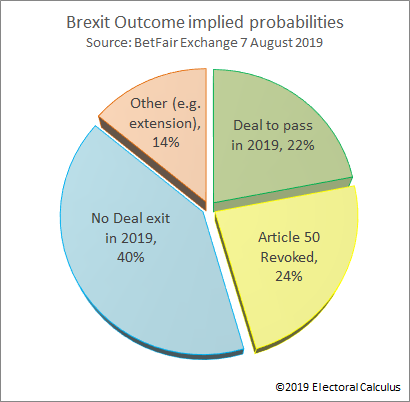
After the tumult of the EU elections, British politics appears to be settling back to a two-party system, as Conservatives and Labour are the two most popular parties again.
| Party | GE Votes | GE Seats | Pred Votes | Pred Seats |
|---|---|---|---|---|
| CON | 43.5% | 318 | 30.7% | 317 |
| LAB | 41.0% | 262 | 26.0% | 221 |
| LIB | 7.6% | 12 | 17.6% | 40 |
| Brexit | 0.0% | 0 | 13.7% | 0 |
| Green | 1.7% | 1 | 5.6% | 1 |
| SNP | 3.1% | 35 | 3.2% | 50 |
| PC | 0.5% | 4 | 0.6% | 3 |
| N.Ireland | 18 | 18 |
Prediction based on poll-of-polls, five polls (Opinium, DeltaPoll, ComRes, Ipsos-MORI, YouGov) from 24-Jul-2019 to 30-Jul-2019, sampling 9,084 people.
This has the Conservatives as the largest party, but short 9 seats of an overall majority. Although this is very similar to the result of the 2017 general election, it is much better than the Conservatives were predicted to achieve recently.
With the apparent return of two-party politics, there are some simple rules of thumb which can help understand the political situation at a glance. These are based on the key number which is the percentage lead of the Conservatives over Labour, or vice versa, in the opinion polls. This is currently about 5pc according to the recent polls used above.
Here are the three rules of thumb:
The Conservatives' current lead of 5pc is just short of the 6pc threshold, and is 4pc lower than what is needed for a health majority.
As noted elsewhere, there is a division among pollsters between those who think the Conservative lead is small and those who think it is significantly larger. The second group of pollsters consists of YouGov and Ipsos-MORI, whereas the first group consists of everyone else.
If we take two separate polls-of-poll over the two groups, we get very different answers.
Labour/Lib Dem/
|
| Party | Low Group polls | Predicted Seats |
|---|---|---|
| CON | 29.7% | 296 |
| LAB | 27.7% | 245 |
| LIB | 16.7% | 37 |
| Brexit | 14.7% | 0 |
| Green | 4.7% | 1 |
| SNP | 3.2% | 50 |
| PC | 0.6% | 3 |
Prediction based on three polls
(from Opinium, DeltaPoll, ComRes)
sampled from 24-Jul-2019 to 28-Jul-2019,
sampling 6,011 people.
| Party | High Group polls | Predicted Seats |
|---|---|---|
| CON | 32.1% | 359 |
| LAB | 22.1% | 177 |
| LIB | 19.6% | 42 |
| Brexit | 12.2% | 0 |
| Green | 7.6% | 1 |
| SNP | 3.2% | 50 |
| PC | 0.6% | 3 |
Prediction based on three polls
(from YouGov, Ipsos-Mori)
sampled from 25-Jul-2019 to 30-Jul-2019,
sampling 4,770 people
The first group, the Low Group has a Conservative lead over Labour of just 2pc, which just makes the Conservatives the largest party, but Jeremy Corbyn would likely be Prime Minister at the head of a progressive alliance along with the Liberal Democrats and the Scottish Nationalists.
The second group, the High Group has a Conservative lead over Labour of 10pc, which is enough for a strong majority in the Commons, with Boris Johnson remaining as Prime Minister.
With the formation of the new government under Boris Johnson, the chance of a No Deal Brexit has increased. According to the political betting markets it is now the most likely single outcome, though with less than half a chance of happening.
| Outcome | Probability |
|---|---|
| No Deal Brexit in 2019 | 40pc |
| Deal to pass Commons in 2019 | 22pc |
| Article 50 to be revoked | 24pc |
| Other (eg further extension) | 14pc |
Source: Betfair Exchange (prices as at 7 August 2019, 15:50).
